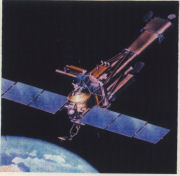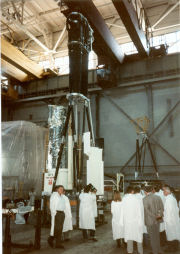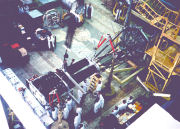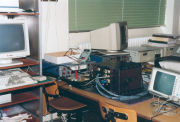








|
The
Spectr-X-Gamma project
Spektr-RG (Russian for Spectrum + Röntgen + Gamma;
also called Spectrum-X-Gamma, SRG, SXG) is an international high-energy
astrophysics observatory, which is being built under the leadership of
the Russian Space Research Institute (IKI). Spektr-RG instrumentation
includes 5 telescopes spanning the energy range from the far
ultraviolet to the hard X-ray, plus an all-sky monitor. The technical
design of the main scientific instruments has been finished in 1992. In
1994 most of scientific instruments were passing through electrical
tests. It is planned to finish complex tests of the scientific payload
by the end of 1994. The total weight of scientific payload planed max.
2,850 kg. The scientific payload of the observatory includes:
- Multimirror grazing incidence X-ray telescope SODART. To be
deployed after the launch, it has 124 m2 total surface areas of the
X-ray mirrors. Two modules of mutlimirror system will have eight
changeable focal plane detectors - proportional counters, solid state
and Bragg spectrometers and polarimeter. The TAUVEX ultraviolet
telescope is coaligned with X-ray mirrors system.
- JET-X multimirror grazing incidence X-ray telescope. Both
of two coaligned multimirror systems have cooled CCD matrices as X-ray
detectors and will provide high angular resolution imaging (20") and
fine spectroscopy (2% at 7keV).
- MART/LIME X-ray coded mask telescope is optimized for
imaging and spectroscopy in the hard X-ray range.
- EUVITA normal incidence telescope for extreme ultraviolet.
- MOXE all-sky X-ray monitor SPIN Gamma-ray burst detector.
- DIOGEN cooled germanium detector for fine spectroscopy of
Gamma-ray bursts.
The available human resources of SGF Co. Ltd. as employes of KFKI RMKI
(prsently Wigner RCP) participated in the development of the fault
tolerenat central data acquisition on control computer (Russian name -
BIUS) and of its electrical ground support equipment.
In order to avoid a malfunction due to any
kind of erroneous operation of the external experiments, the BIUS has a
modular construction in one hand; on the other hand, the external units
and the modules of the BIUS are connected together on reserved,
galvanically isolated, serial buses. The BIUS is composed of different,
self-functioning modules having their own power supplies and the
possibility of switching on/off independently of each other. The other
advantage of modularity is that by implementing a standard protocol for
data exchange, it makes possible to work out various flexible
reservation methods. The processor module uses an 80C86-type
processor; its memory (PROM, EEPROM and RAM ) is 16 bits wide and
protected with Hamming code.
The observatory was scheduled to fly in late 1995. Russian PROTON
rocket planned to launch the spacecraft on to highly eccentric 4 days
orbit with inclination 51.6 degrees. Initially, the apogee of the orbit
will be 200,000 km, perigee - 500 km. Such orbit parameters enables to
perform X-ray observations during three days out of each four, when the
spacecraft is beyond the Earth radiation belts.
The operations with SRG spacecraft planned to managed and run by
russian engineers from one of the tracking stations in Moscow district.
Direct contacts between satellite and ground station planned to
performed once per day. The capacity of fast telemetry link planned 1
Mbit/sec. The expected amount of raw scientific data from spacecraft
planned ~10 Gbit per day. The spacecraft planned to observe upto 10
different targets per day, the repointings being performed
automatically without direct contact with the ground station.
In 1997 the flight model of BIUS was ready, but the launch date
postponed from finantial reason many times and the result was the KFKI
RMKI withdraw his activity. Development of this early SRG version
finally was cancelled in 2002.
24.December 2014
|

SRG
satelite, fantazy

Integration
of SRG at
Lavochkin Association

Integtration
of SRG at Lavochkin Association

Fault
tolerant central computer test at KFKI
|


